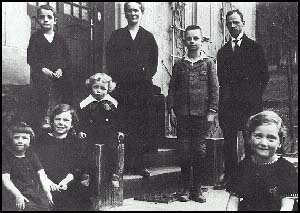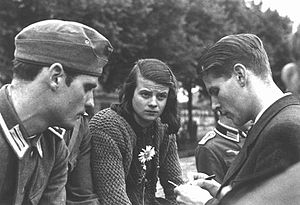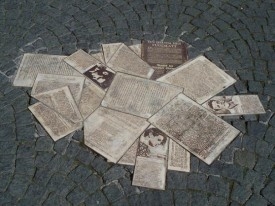It takes guts to stand for what you believe is right. Sophie Scholl did just that during one of the most terrible times here on earth. Sophie knew that standing up for her beliefs could cost her her life but that was a risk she was willing to take. The Holocaust affected the lives of many people, if not all. About 6 million Jews were killed during this time. Sophie Scholl was and is a hero because she lived through the hardest of times, she helped form a resistance, and she left a legacy for others.
 |
| Scholl Family Photo (http://www.spartacus.schoolnet.co.uk/GERschollS.htm) |
Sophie was born on May 9th, 1921. At the age of 12 she became a part of the Hitler Youth, which she was excited about at first. But when her father shared his views of Adolf Hitler and his Nazi government she became critical of them and their intentions. Sophie's brother also shared these views; in 1937 he was arrested and briefly jailed after being accused of subversive activities. After leaving school in 1940 Sophie became a kindergarten teacher at the Frobel Institute in Ulm-Soflingen. Then she went on to do six months of auxiliary war serice as a nursery teach in Blumberg.
 |
| Sophie Scholl (http://wpcontent.answcdn.com/wikipedia/en/thumb/c/cf/WhiteRose.jpg/300px-WhiteRose.jpg) |
In May 1942, Sophie entered the University of Munich where she became a student of biology and philosophy. It was there that her brother, Hans, her sister, Inge, Christoph Probst, Alexander Schmorell, Willi Graf, Jugen Wittenstein, Kurt Huber, and Sophie formed the White Rose. The White Rose was a non-violence resistance group who believed that the young people of Germany had the potential to overthrow Adolf Hitler and the Nazi government. They did this by publishing leaflets that called for the restoration of a democracy and social justice. These were distributed all over central Germany. One of their leaflets said, "The name of Germany is dishonored for all time if German youth does not finally rise, take revenge, smash its tormentors. Students! The German people look to us." Soon the Gestapo was aware of the groups' activities.
On February 18th, Hans and Sophie Scholl began distributing leaflets. Jakob Schmidt, a member of the Nazi Party, saw them throwing the leaflets from a window of the third floor into the courtyard below. He immediately told the Gestapo and they were both arrested. They were searched and the police found a handwritten draft of another leaflet. Eventually everyone involved in the White Rose and was sentenced to death. The White Roses' resistance didn't stop there; leaflets were gathered and smuggled out of Germany. The group was given a new identity, The Manifesto of the Students of Munich. There have been countless books and movies based on Sophie and her courage, streets named after her and other group members, and the respect of millions for what they did.
 |
| White Rose Memorial (http://exponent.uah.edu/wp-content/uploads/2008/09/memorial1-275x206.jpg) |
What Sophie and the White Rose did is seen as a demonstration of exemplary spiritual courage. Lillian Garrett-Groag stated in Newsday on February 22, 1993, that "It is possibly the most spectacular moment of resistance I can think of in the 20th century...The fact that five little kids, in the mouth of the wolf, where it really counted, had the tremendous.. courage to do what they did, is spectacular to me. I know the world is better for them having been there." Sophie was a true heron in her actions of resistance and encouraging others to stand up for what they believe. Her story inspires others to do hard things Sophie said it best when she stated, "Stand up for what you believe in even if you are standing alone."
Page created on 9/30/2011 12:00:00 AM
Last edited 9/30/2011 12:00:00 AM
